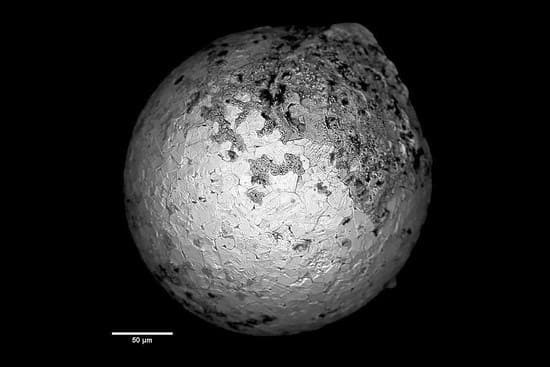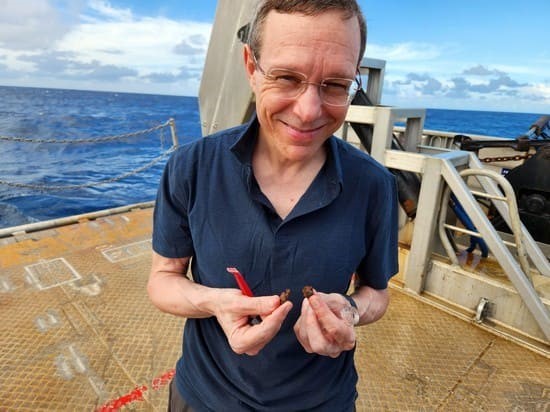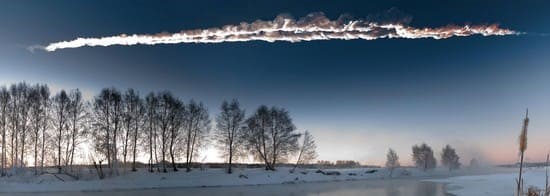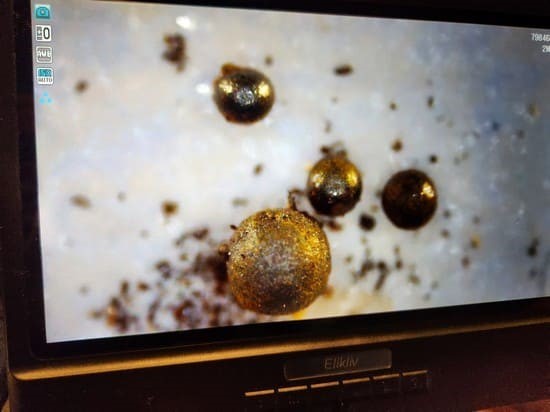Scientist’s deep dive for alien life leaves his peers dubious
New York Times
last updated: Jul 25,2023

On Jan. 8, 2014, a fireball from space blazed through
Earth’s atmosphere and crashed into the sea, north of Manus Island off the
northeastern coast of Papua New Guinea. Its location, velocity and brightness
were recorded by US government sensors and quietly tucked away in a database of
similar events.اضافة اعلان
That data sat for five years, a source of no contention until Avi Loeb, a theoretical astrophysicist at Harvard University, and Amir Siraj, then an undergraduate student at the university, stumbled across it in 2019. Based on its logged speed and direction, Siraj identified the fireball as an extreme outlier.
Last month, Loeb led an expedition to retrieve fragments of the fireball off the western Pacific seafloor. On June 21, he claimed that he had. And such discoveries, he says to the chagrin of many of his colleagues, may be the way scientists find evidence of extraterrestrial life.
“Not biological creatures, the way you see in science fiction movies,” Loeb said. “It’s most likely a technological gadget with artificial intelligence.”
Many astronomers, though, see the announcement as the latest example of Loeb making an outlandish declaration that is too strong and too hasty. His pronouncements (and a promotional video in Times Square about the search for extraterrestrial life) skew public perception of how science actually works, they say.

An image provided by Harvard University shows an an electron microprobe view of a spherule recovered from the bottom of the Pacific Ocean. Dr. Avi Loeb believes these spherules are evidence that a meteor that crashed in the area came from outside our solar system.
“People are sick of hearing about Avi Loeb’s wild claims,” said Steve Desch, an astrophysicist at Arizona State University. “It’s polluting good science — conflating the good science we do with this ridiculous sensationalism and sucking all the oxygen out of the room.”
Desch added that several of his colleagues were now refusing to engage with Loeb’s work in peer review, the process by which scholars evaluate one another’s research to ensure that only high-quality studies are published. “It’s a real breakdown of the peer review process and the scientific method,” he said. “And it’s so demoralizing and tiring.”
For much of his career, Loeb has been a powerhouse of a cosmologist, churning out hundreds of papers on black holes, dark matter, the first stars and the fate of our universe. But he has been captivated by the search for aliens since an interstellar object named Oumuamua zoomed by our planet in 2017. While scientists debated whether that visitor was an asteroid or a comet from another star system, Loeb made the case that it could be an artifact of intelligent life.
Loeb also began studying the fireball catalog from the Center for Near Earth Object Studies at NASA. That led to the object that had been detected in 2014. From its direction and speed at impact — 45km per second — Loeb and Siraj concluded that the fireball had been moving too fast for something gravitationally bound to our sun. That meant, like Oumuamua, it must also have been interstellar.
That appeal to authority isn’t enough, said Peter Brown, a meteor physicist at Western University in Ontario. It’s unknown how precise the US Defense Department data is, which affects how likely it is that the object came from beyond.
“We know from experience, running ground-based radar and optical networks, that you often find several percent of all the events you detect appear to be interstellar,” Brown said. To date, he continued, nearly all of those events could be chalked up to measurement error.

Brown and others have also been troubled by the lack of engagement Loeb has had with the community of experts who study fast-flying fireballs.
Loeb’s recent ocean expedition to salvage remnants of the meteor in question was financed with $1.5 million from Charles Hoskinson, a cryptocurrency entrepreneur, and organized through EYOS Expeditions. The voyage took place about 60 nautical miles north of Manus Island along the expected path of the 2014 fireball. A group of scientists, engineers and sailors and a film crew, as well as Hoskinson, accompanied Loeb. He has documented the voyage and its aftermath in a 42-part (and counting) series of self-published blog posts.
For two weeks, the science team dragged a custom-built sled equipped with magnets, cameras and lights across the seafloor, retrieving it at regular intervals to search for metallic bits of the 2014 fireball stuck to its surface. In the end, they recovered scores of glimmering beads, each less than a millimeter in diameter. Preliminary analyses performed on the ship showed these spherules to be made mostly of iron, with lesser amounts of other metals.
That’s not commonly found in the waters around Manus Island, said Maurice Tivey, a marine geophysicist at Woods Hole Oceanographic Institution who was not involved in the expedition but who once used underwater robots to map that region of the seafloor. Instead, sediments and volcanic ash are prolific — material that doesn’t move around much once it has settled on the ocean bottom.

That, combined with the roundness of the recovered fragments — suggesting they were once aerodynamic — seemed pretty conclusive to Tivey. “So I do think he’s found pieces of it,” he said.
Skepticism about the endeavor flared at a recent Asteroids, Comets, Meteors Conference that occurred while the deep sea expedition was underway. There, Desch argued that had the fireball been moving as fast as reported, there would have been nothing left to find — the meteor would have completely burned up in the atmosphere. Even in the most generous scenario, he said, only a milligram of material would have survived, and it would have been spread out over tens of square kilometers along the ocean floor.
Brown also presented at the conference, describing a recent analysis using data from an assortment of instruments to cross-check measurements for 17 of the objects listed in the same NASA fireball catalog used by Loeb and Siraj. His results, which have been accepted for publication in The Astrophysical Journal, indicate that the catalog data often gets directions and speeds wrong and that the size of the error for speed measurements increases for objects with greater speed.

Those errors are big enough to move the 2014 fireball from an unbound orbit to a bound one, Brown explained — meaning it might not have been interstellar after all. He found that if the object had actually been traveling at closer to 20km per second at impact, its reported brightness, density and air drag better fit theoretical models of meteors.
On that basis, Brown concluded that the fireball most likely impacted at a lower speed. “If the speed was overestimated, then the object becomes, more or less, within the realm of what we see in terms of other bound solar system objects,” he said.
Loeb disagreed with that pushback.
“When I was educated as a physicist, I was told when you have a model and it doesn’t agree with the data, it means you have to revise your model,” he said, referring to measurements in the NASA catalog.
He also believes, unlike many of his colleagues, that the US military sensors are trustworthy, even though he lacks access to their raw readings. “They are responsible for national security,” Loeb said. “I think they know what they are doing.” That he and his team found what they think are fragments of the 2014 meteor at the location indicated by those measurements only makes him more confident.
It’s unlikely that the government will declassify how precise those devices’ data is. So Loeb is banking on a different kind of proof: He has sent the spherules to labs at Harvard University, the University of California, Berkeley, and the Bruker Corp. in Germany for rigorous analysis and dating. Spherules older than our solar system, or with a distinct isotopic signature, must be interstellar.
At Berkeley, Loeb performed some of the first inspections himself. Early tests revealed the presence of uranium and lead, the abundance of which can be used to estimate the material’s age. Two of the spherules found along the expected path of the fireball appear to be as old as the universe itself, Loeb claims.
That’s in contrast to a spherule recovered away from the fireball’s path, which Loeb anticipates is either geological in origin or from a different meteorite. He estimated this spherule to have an age of a few billion years, comparable to that of our solar system.
But even if the fireball really did come from another cosmic neighborhood, far more evidence is needed to show that the spherules are linked to extraterrestrial life.
He is open to the possibility that he is mistaken, but he also likes to invoke scientific luminaries in response to such concerns. “Einstein was wrong three times,” he said, referring to supermassive black holes, gravitational waves, and quantum entanglement — all discoveries that have since been recognized with Nobel Prizes in physics. “It’s valuable to test ideas experimentally,” Loeb said. “Let the evidence be the guide.”
According to Desch, the meteor community does believe interstellar objects are out there, and they’re eager for one to strike the Earth — there just hasn’t been strong evidence yet that it has happened. “I just want to assure the public that scientists don’t make stuff up,” he said. “What the public is seeing in Loeb is not how science works. And they shouldn’t go away thinking that.”
The public may hear more from Loeb about additional bits of rock from the bottom of the sea. Later this year, his team intends to return to the waters north of Papua New Guinea to hunt for larger relics of the 2014 fireball. And in 2024, the team says it will visit a site off the coast of Portugal in search of the remains from a second meteor Loeb and Siraj have asserted is of interstellar origin.
“He might be wrong,” said Rob McCallum, a co-founder of EYOS Expeditions and the primary organizer of the recent expedition, adding, “but we’ll never know unless we look.”
Read more Odd and Bizarre
Jordan News
That data sat for five years, a source of no contention until Avi Loeb, a theoretical astrophysicist at Harvard University, and Amir Siraj, then an undergraduate student at the university, stumbled across it in 2019. Based on its logged speed and direction, Siraj identified the fireball as an extreme outlier.
Last month, Loeb led an expedition to retrieve fragments of the fireball off the western Pacific seafloor. On June 21, he claimed that he had. And such discoveries, he says to the chagrin of many of his colleagues, may be the way scientists find evidence of extraterrestrial life.
“Not biological creatures, the way you see in science fiction movies,” Loeb said. “It’s most likely a technological gadget with artificial intelligence.”
Many astronomers, though, see the announcement as the latest example of Loeb making an outlandish declaration that is too strong and too hasty. His pronouncements (and a promotional video in Times Square about the search for extraterrestrial life) skew public perception of how science actually works, they say.

An image provided by Harvard University shows an an electron microprobe view of a spherule recovered from the bottom of the Pacific Ocean. Dr. Avi Loeb believes these spherules are evidence that a meteor that crashed in the area came from outside our solar system.
“People are sick of hearing about Avi Loeb’s wild claims,” said Steve Desch, an astrophysicist at Arizona State University. “It’s polluting good science — conflating the good science we do with this ridiculous sensationalism and sucking all the oxygen out of the room.”
Desch added that several of his colleagues were now refusing to engage with Loeb’s work in peer review, the process by which scholars evaluate one another’s research to ensure that only high-quality studies are published. “It’s a real breakdown of the peer review process and the scientific method,” he said. “And it’s so demoralizing and tiring.”
For much of his career, Loeb has been a powerhouse of a cosmologist, churning out hundreds of papers on black holes, dark matter, the first stars and the fate of our universe. But he has been captivated by the search for aliens since an interstellar object named Oumuamua zoomed by our planet in 2017. While scientists debated whether that visitor was an asteroid or a comet from another star system, Loeb made the case that it could be an artifact of intelligent life.
Loeb also began studying the fireball catalog from the Center for Near Earth Object Studies at NASA. That led to the object that had been detected in 2014. From its direction and speed at impact — 45km per second — Loeb and Siraj concluded that the fireball had been moving too fast for something gravitationally bound to our sun. That meant, like Oumuamua, it must also have been interstellar.
When I was educated as a physicist, I was told when you have a model and it doesn’t agree with the data, it means you have to revise your model,They wrote a paper about the discovery in 2019. It was initially rejected by The Astrophysical Journal, but the same journal then accepted it for publication in November, several months after US Space Command announced in a memo circulated on Twitter that measurements of the fireball’s velocity were accurate enough to infer interstellar origin.
That appeal to authority isn’t enough, said Peter Brown, a meteor physicist at Western University in Ontario. It’s unknown how precise the US Defense Department data is, which affects how likely it is that the object came from beyond.
“We know from experience, running ground-based radar and optical networks, that you often find several percent of all the events you detect appear to be interstellar,” Brown said. To date, he continued, nearly all of those events could be chalked up to measurement error.

Brown and others have also been troubled by the lack of engagement Loeb has had with the community of experts who study fast-flying fireballs.
Loeb’s recent ocean expedition to salvage remnants of the meteor in question was financed with $1.5 million from Charles Hoskinson, a cryptocurrency entrepreneur, and organized through EYOS Expeditions. The voyage took place about 60 nautical miles north of Manus Island along the expected path of the 2014 fireball. A group of scientists, engineers and sailors and a film crew, as well as Hoskinson, accompanied Loeb. He has documented the voyage and its aftermath in a 42-part (and counting) series of self-published blog posts.
For two weeks, the science team dragged a custom-built sled equipped with magnets, cameras and lights across the seafloor, retrieving it at regular intervals to search for metallic bits of the 2014 fireball stuck to its surface. In the end, they recovered scores of glimmering beads, each less than a millimeter in diameter. Preliminary analyses performed on the ship showed these spherules to be made mostly of iron, with lesser amounts of other metals.
That’s not commonly found in the waters around Manus Island, said Maurice Tivey, a marine geophysicist at Woods Hole Oceanographic Institution who was not involved in the expedition but who once used underwater robots to map that region of the seafloor. Instead, sediments and volcanic ash are prolific — material that doesn’t move around much once it has settled on the ocean bottom.

That, combined with the roundness of the recovered fragments — suggesting they were once aerodynamic — seemed pretty conclusive to Tivey. “So I do think he’s found pieces of it,” he said.
Skepticism about the endeavor flared at a recent Asteroids, Comets, Meteors Conference that occurred while the deep sea expedition was underway. There, Desch argued that had the fireball been moving as fast as reported, there would have been nothing left to find — the meteor would have completely burned up in the atmosphere. Even in the most generous scenario, he said, only a milligram of material would have survived, and it would have been spread out over tens of square kilometers along the ocean floor.
Brown also presented at the conference, describing a recent analysis using data from an assortment of instruments to cross-check measurements for 17 of the objects listed in the same NASA fireball catalog used by Loeb and Siraj. His results, which have been accepted for publication in The Astrophysical Journal, indicate that the catalog data often gets directions and speeds wrong and that the size of the error for speed measurements increases for objects with greater speed.

Those errors are big enough to move the 2014 fireball from an unbound orbit to a bound one, Brown explained — meaning it might not have been interstellar after all. He found that if the object had actually been traveling at closer to 20km per second at impact, its reported brightness, density and air drag better fit theoretical models of meteors.
On that basis, Brown concluded that the fireball most likely impacted at a lower speed. “If the speed was overestimated, then the object becomes, more or less, within the realm of what we see in terms of other bound solar system objects,” he said.
Loeb disagreed with that pushback.
“When I was educated as a physicist, I was told when you have a model and it doesn’t agree with the data, it means you have to revise your model,” he said, referring to measurements in the NASA catalog.
He also believes, unlike many of his colleagues, that the US military sensors are trustworthy, even though he lacks access to their raw readings. “They are responsible for national security,” Loeb said. “I think they know what they are doing.” That he and his team found what they think are fragments of the 2014 meteor at the location indicated by those measurements only makes him more confident.
It’s unlikely that the government will declassify how precise those devices’ data is. So Loeb is banking on a different kind of proof: He has sent the spherules to labs at Harvard University, the University of California, Berkeley, and the Bruker Corp. in Germany for rigorous analysis and dating. Spherules older than our solar system, or with a distinct isotopic signature, must be interstellar.
At Berkeley, Loeb performed some of the first inspections himself. Early tests revealed the presence of uranium and lead, the abundance of which can be used to estimate the material’s age. Two of the spherules found along the expected path of the fireball appear to be as old as the universe itself, Loeb claims.
That’s in contrast to a spherule recovered away from the fireball’s path, which Loeb anticipates is either geological in origin or from a different meteorite. He estimated this spherule to have an age of a few billion years, comparable to that of our solar system.
But even if the fireball really did come from another cosmic neighborhood, far more evidence is needed to show that the spherules are linked to extraterrestrial life.
We know from experience, running ground-based radar and optical networks, that you often find several percent of all the events you detect appear to be interstellar,According to Don Brownlee, an astronomer at the University of Washington who used magnets to collect cosmic marbles off the seafloor in the 1970s, if the spherules don’t contain nickel, they’re probably not from a natural meteorite. On the other hand, he says, if no oxygen is found, it’s unlikely the material passed through Earth’s atmosphere. Loeb has already written that early results revealed an absence of nickel, but he did not mention oxygen.
He is open to the possibility that he is mistaken, but he also likes to invoke scientific luminaries in response to such concerns. “Einstein was wrong three times,” he said, referring to supermassive black holes, gravitational waves, and quantum entanglement — all discoveries that have since been recognized with Nobel Prizes in physics. “It’s valuable to test ideas experimentally,” Loeb said. “Let the evidence be the guide.”
According to Desch, the meteor community does believe interstellar objects are out there, and they’re eager for one to strike the Earth — there just hasn’t been strong evidence yet that it has happened. “I just want to assure the public that scientists don’t make stuff up,” he said. “What the public is seeing in Loeb is not how science works. And they shouldn’t go away thinking that.”
The public may hear more from Loeb about additional bits of rock from the bottom of the sea. Later this year, his team intends to return to the waters north of Papua New Guinea to hunt for larger relics of the 2014 fireball. And in 2024, the team says it will visit a site off the coast of Portugal in search of the remains from a second meteor Loeb and Siraj have asserted is of interstellar origin.
“He might be wrong,” said Rob McCallum, a co-founder of EYOS Expeditions and the primary organizer of the recent expedition, adding, “but we’ll never know unless we look.”
Read more Odd and Bizarre
Jordan News

